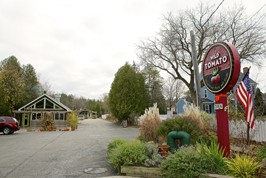FEMA Conducting Great Lakes Coastal Flood Study
- Share
- Tweet
- Pin
- Share

Mariah Goode (left) and Sue Vanden Langenberg of the Door County Planning Department examine floodplain maps, as FEMA is currently working on a new Great Lakes Coastal Flood Study with the aim of producing updated flood insurance rate maps for the entire Great Lakes coastline by the end of 2015. Submitted photo.
In 2009, Britt Unkefer was looking to expand his Fish Creek restaurant, Wild Tomato, when he found out a surprising piece of information: his property was apparently located in a floodplain, and that meant there weren’t a lot of expansion options open to him.
“It was limiting in that we basically couldn’t do anything to the property,” said Unkefer. “What it would have made us do if we wanted to add on is raise the additions two feet, and it would have been impossible to make something work that way.”
Door County first adopted floodplain zoning and flood insurance rate maps – which track base flood elevations and areas of a community that are more likely to flood – in 1982. The county received a new, updated map from FEMA as part of a statewide revision in 2009, which put Wild Tomato in the floodplain.
Now, FEMA is conducting a new Great Lakes Coastal Flood Study with the aim of producing updated flood insurance rate maps for the entire Great Lakes coastline by the end of 2015, and it’s possible that more people may end up in a situation like Unkefer’s.
“Probably the biggest fear with any new mapping process is the fear of more property being put into the floodplain and higher elevations,” said Sue Vanden Langenberg, zoning administrator with the Door County Planning Department.
“I think a lot of shoreline property owners would consider that a slap in the face considering how low the water levels are, but then…it can and does come back,” said Mariah Goode, director of the Door County Planning Department.
When a property is placed in the floodplain any building constructed on it is required to meet an elevation standard to prevent flood damage, and the property owner is required to purchase flood insurance if they want to get a mortgage.
If a building already exists on a property placed in the floodplain and it doesn’t meet floodplain specifications, the property owner is required to purchase flood insurance and may also be limited in the modifications they can make to the building.
This is exactly what happened to Unkefer.
“We weren’t given any notice,” said Unkefer. “When we were in the middle of planning the expansion the county came to us and said you can’t do anything unless you do x, y, and z.”

Britt Unkefer at the Wild Tomato in Fish Creek was hit by surprise when he discovered his property was located within the floodplain while he was working on expansion plans in 2009. Photo by Len Villano.
A large number of the properties around Wild Tomato were also placed in the floodplain, and some of them were able to petition FEMA to get out of it via a map amendment. But going through the process is costly, and it doesn’t guarantee a property will be placed out of the floodplain.
“The only step we could take was to have a survey company come and re-map the area, which would cost over $20,000, and pay $4,000 to submit an application to FEMA,” said Unkefer.
Brian “Stretch” Merkel’s bike shop, Nor Door Sport & Cyclery, was built just prior to the 2009 floodplain mapping. It sits one property away from Wild Tomato and was also placed in the floodplain zone without any notice.
“I went to refinance, and that’s where it showed up,” said Merkel. “I’m fortunate I did what I did when I did. I tore down the house and the garage and rebuilt, and there’s no way I could have done that being in a floodplain.”
Still, Merkel now pays about $2,500 annually for flood insurance as a result of being placed in the floodplain.
“I’ve only been here 34 years, but I’ve never seen a flood,” said Merkel. “I’ve talked to some of the people who’ve lived here all their lives, 75 or 80 years, and they’ve never seen a flood.”
According to FEMA, 34 flood insurance claims have been made in Door County since 1978, and $180,031 have been paid out to cover those claims. Those claims can only be made if the county is certified by and in compliance with the floodplain maps drawn by the state and federal government.
“An example is Lake Delton, where the dam burst a couple years ago,” said Goode. “That village had said, ‘We’re not going to flood,’ and so had not adopted a floodplain ordinance. It’s my understanding that none of those property owners were eligible for flood relief because of that.”
The new mapping process will incorporate a lot more data than the previous process, including models that map storm surges and the resulting waves.
Storm surge and wave data was used when drawing Brown County’s new floodplain maps in the late 2000s, and according to Vanden Langenberg and Goode, the results were dramatic.
“[That] increased some elevations on waterfront property by five or six feet, as opposed to inches on our map. So there was a lot of dismay there,” said Vanden Langenberg. “And they did get the political powers involved because it was such an impossible map to deal with.”
“I think they’re hoping that whatever science and engineering that’s [being used in this study] will be more realistic or specific than what led to the maps they have now,” said Goode.
The last time Door County was re-mapped local officials were largely not included in the process.
This time, the county has been emailing back and forth with the contractors involved in the study to provide input on where data should be gathered. The county is also in the process of crafting a resolution asking to be informed and involved throughout the mapping process.
“The point of the resolution and the input that we’ve been giving is to say, ‘Okay, we would like you to listen to us,’” said Goode. “There’s nothing wrong with having a study that’s as accurate as possible and data that’s as accurate as possible because I suppose there is the potential out there that properties are going to flood at some point.”

